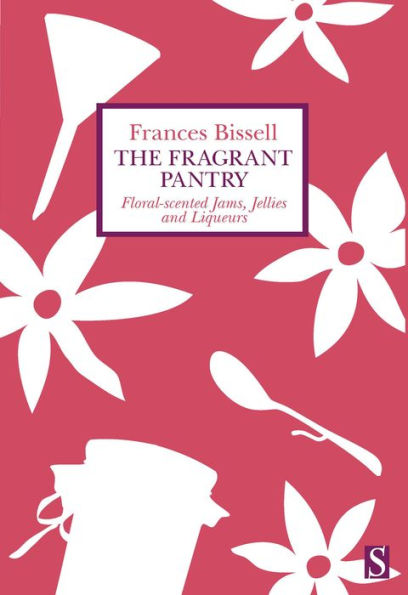An already acclaimed cookbook by James Beard award winning chef Frances Bissell setting out the techniques and recipes for the use of flowers in the kitchen.
While the use of flowers in cookery is becoming ever more popular, they often feature as little more than decoration. In The Fragrant Pantry, the third volume of an already acclaimed trilogy, Frances Bissell shows us how the scent and flavor of flowers can be used like that of an herb or a spice to add magic to a range of dishes.
In these pages you will find recipes for preserves as diverse as myrtle-scented figs, peach and lavender mostarda, rum and jasmine mincemeat, wild garlic flower pesto, mango, jasmine and lime kulfi, elderflower, cucumber and lemon gin and "gorgeous gillyflower grappa." You will also discover how the delicate taste of rose petals can transform raspberry ice cream. And you will learn the way in which fresh edible flowers or floral extracts can be used to create exquisite preserves.
For Frances Bissell cooking with flowers is not a fad or a fashion, but a natural way of cooking which reflects the seasons, and which owes much to English culinary traditions going back over centuries. These easy-to-follow recipes allow both the experienced and novice cook to experiment with floral cooking with real confidence.
1126534452
While the use of flowers in cookery is becoming ever more popular, they often feature as little more than decoration. In The Fragrant Pantry, the third volume of an already acclaimed trilogy, Frances Bissell shows us how the scent and flavor of flowers can be used like that of an herb or a spice to add magic to a range of dishes.
In these pages you will find recipes for preserves as diverse as myrtle-scented figs, peach and lavender mostarda, rum and jasmine mincemeat, wild garlic flower pesto, mango, jasmine and lime kulfi, elderflower, cucumber and lemon gin and "gorgeous gillyflower grappa." You will also discover how the delicate taste of rose petals can transform raspberry ice cream. And you will learn the way in which fresh edible flowers or floral extracts can be used to create exquisite preserves.
For Frances Bissell cooking with flowers is not a fad or a fashion, but a natural way of cooking which reflects the seasons, and which owes much to English culinary traditions going back over centuries. These easy-to-follow recipes allow both the experienced and novice cook to experiment with floral cooking with real confidence.
The Fragrant Pantry: Floral Scented Jams, Jellies and Liqueurs
An already acclaimed cookbook by James Beard award winning chef Frances Bissell setting out the techniques and recipes for the use of flowers in the kitchen.
While the use of flowers in cookery is becoming ever more popular, they often feature as little more than decoration. In The Fragrant Pantry, the third volume of an already acclaimed trilogy, Frances Bissell shows us how the scent and flavor of flowers can be used like that of an herb or a spice to add magic to a range of dishes.
In these pages you will find recipes for preserves as diverse as myrtle-scented figs, peach and lavender mostarda, rum and jasmine mincemeat, wild garlic flower pesto, mango, jasmine and lime kulfi, elderflower, cucumber and lemon gin and "gorgeous gillyflower grappa." You will also discover how the delicate taste of rose petals can transform raspberry ice cream. And you will learn the way in which fresh edible flowers or floral extracts can be used to create exquisite preserves.
For Frances Bissell cooking with flowers is not a fad or a fashion, but a natural way of cooking which reflects the seasons, and which owes much to English culinary traditions going back over centuries. These easy-to-follow recipes allow both the experienced and novice cook to experiment with floral cooking with real confidence.
While the use of flowers in cookery is becoming ever more popular, they often feature as little more than decoration. In The Fragrant Pantry, the third volume of an already acclaimed trilogy, Frances Bissell shows us how the scent and flavor of flowers can be used like that of an herb or a spice to add magic to a range of dishes.
In these pages you will find recipes for preserves as diverse as myrtle-scented figs, peach and lavender mostarda, rum and jasmine mincemeat, wild garlic flower pesto, mango, jasmine and lime kulfi, elderflower, cucumber and lemon gin and "gorgeous gillyflower grappa." You will also discover how the delicate taste of rose petals can transform raspberry ice cream. And you will learn the way in which fresh edible flowers or floral extracts can be used to create exquisite preserves.
For Frances Bissell cooking with flowers is not a fad or a fashion, but a natural way of cooking which reflects the seasons, and which owes much to English culinary traditions going back over centuries. These easy-to-follow recipes allow both the experienced and novice cook to experiment with floral cooking with real confidence.
9.99
In Stock
5
1

The Fragrant Pantry: Floral Scented Jams, Jellies and Liqueurs

The Fragrant Pantry: Floral Scented Jams, Jellies and Liqueurs
Related collections and offers
9.99
In Stock

From the B&N Reads Blog
